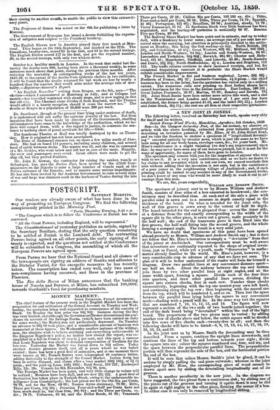A NEW JOINT IN JOINERY.
The following letter, received on Saturday last week, speaks very ably for itself and its writers Scotch Fancy- Wood Works, Mareckline, Ayrshire, 5111 October, 1859. Se—In the Glasgow Saturday Post, of the 1st instant, we observe an article with the above heading, extracted from your valuable periodical describing an invention patented by 31r. Hine, of St. John Street Road, and we take the freedom to enclose a specimen of " longitudinal dovetail- ing " executed entirely- by circular saws, which is just the game _as we have
been using for all our work-boxes, envelope-cases, for years back. Mr. hue's contrivance is a slight variation (we don't say itnprovement) upon this : he may never have seen any of our boxes sojointed, but it is not for the want of opportunity, for many of them have gone to London.
The specimen may remain with you for the inspection of anyone who may wish to see it. It 18 a very nice contrivance, and as we have no desire to lay claims to any invention which is not our own, we eannot conclude this note without adding that the invention is not ours but is the contrivance of a poor joiner in the neighbouring village of ours, and, if such jointing could be turned to any account in any of the Gov.ertunent works, we don't know of any man who -would be more likelyto week it out to ad- vantage than this man.
We are, Sir, yours respectfully,
WILLIAM AND ANDREW SMITE.
The specimen of joinery sent to us by Messrs. William and Andrew Smith, consists of four sides of a box-executed in beechwood ; the con- trivance may be described thus. At each end of the side a piece with parallel sides is sawn out to a measure in -depth exactly equal to the thickness of the _board. On what is intended for the inner side, the wall -Of this groove is sawn away to the -extent of half its depth. The board intended for the end is prepared thus : across the inner side, at a distance from the end exactly corresponding to the width of the square slit in the other piece is sawn out a groove, made precisely to -fit the half wall ; the end of the transverse piece is then fitted into the first groove, the half wall fitting into the .second groove, and the whole forming a compact angle. The result is a very solid joint. We have no doubt that specimens of this joint have been spread abroad precisely as Messrs. William and Andrew Smith say ; but it does not follow that Mr. Hine's invention is simply a " deviation " from that of the joiner at Auchinleck. Our correspondents must be well aware -that inventions are continually repeated in the shape of original inven- tions, just as Pascal, while -yet a youth, made " discoveries " in mathe- matics already familiar to the world. Mr. Hine's joint, however, is a very considerable step in advance of any that we have yet seen. The plan of it will be better understood if the reader will form for himself a diagram. Draw two parallel lines at any convenient distance apart— gay half an inch. About the midway between the top and bottom join those by two other parallel lines at right angles, and at the same width apart, forming a square. Divide each of the four lines into quarters, and draw other parallel lines across, dividing the square into sixteen checks, four in each row. 'Number these checks consecutively, beginning with the top one nearest your own left hand, and continuing along the top row ; then beginning with the second one from the top, which will be numbered 5, and so on. Then tint the space between the parallel lines lying below the square in any convenient mode—shading with a pencil will do. In the same way tint the squares that are numbered 7, 10, 11, 12, 15, and 16. The figure will now represent a section of the two ends of two boards joined together; the end of the dark board being 4' dovetailed" within the end of the light board. The proportions of the two pieces -may be varied: by adding another row of checks above and below, the entire square will be divided into five rows of -five checks each—twenty-five in all ; and then the following checks will have to be tinted-8, 9, 12, 13, 14, 15, 17, 18, 19, 20, 23, 24, and 25. In the joint sent us by Messrs. Smith the dovetailing may be thus described. Form a square, continue the upright lines downwards, and continue the lines of the top and -bottom towards your right; divide the square into six ; colour the squares numbered one, four, and six and the space between the perpendicular parallel lines. The perpendicular portion will then represent the side of the box, and the horizontal portion the end of the box.
It will be seen that unless Messrs. Smith's joint be glued, it can be undone by simply pulling the end piece outwards ; whereas in the joint employed by Mr. Hine, the corresponding piece of wood cannot be drawn apart save by sliding the dovetailing longitudinally out of its grooves.
There is another peculiarity in the new joint. In the diagram we have suggested, the two pieces form a continuous slab ; by sliding one of the pieces out of the grooves and turning it upside down it may be slid in again at right angles to the other piece,-forming the corner of a box. In either case it can only be removed by longitudinal sliding.


























 Previous page
Previous page